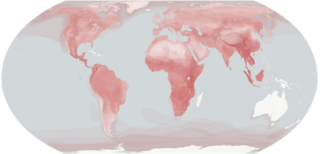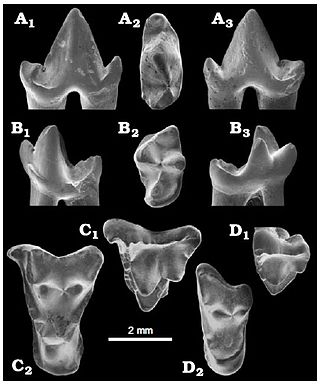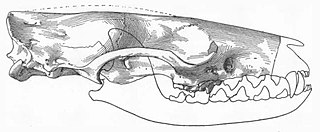
Carnivora is an order of placental mammals that have specialized in primarily eating flesh, whose members are formally referred to as carnivorans. The order Carnivora is the fifth largest order of mammals, comprising at least 279 species.

Tylopoda is a suborder of terrestrial herbivorous even-toed ungulates belonging to the order Artiodactyla. They are found in the wild in their native ranges of South America and Asia, while Australian feral camels are introduced. The group has a long fossil history in North America and Eurasia. Tylopoda appeared during the Eocene around 50 million years ago.

Oxyaenidae is a family of extinct carnivorous placental mammals. Traditionally classified in order Creodonta, this group is now classified in its own order Oxyaenodonta within clade Pan-Carnivora in mirorder Ferae. The group contains four subfamilies comprising fourteen genera. Oxyaenids were the first to appear during the late Paleocene in North America, while smaller radiations of oxyaenids in Europe and Asia occurred during the Eocene.

Viverravidae is an extinct monophyletic family of mammals from extinct superfamily Viverravoidea within the clade Carnivoramorpha, that lived from the early Palaeocene to the late Eocene in North America, Europe and Asia. They were once thought to be the earliest carnivorans and ancestral to extant ones, but now are placed outside the order Carnivora based on cranial morphology as relatives to extant carnivorans.

Miacidae is a former paraphyletic family of extinct primitive placental mammals that lived in North America, Europe and Asia during the Paleocene and Eocene epochs, about 65–33.9 million years ago. These mammals were basal to order Carnivora, the crown-group within the Carnivoraformes.

Miacis is an extinct genus of placental mammals from clade Carnivoraformes, that lived in North America from early to middle Eocene.

Carnivoramorpha is a clade of placental mammals of clade Pan-Carnivora from mirorder Ferae, that includes the modern order Carnivora and its extinct stem-relatives.

Vulpavus is an extinct paraphyletic genus of placental mammals from clade Carnivoraformes, that lived in North America from early to middle Eocene.

Miocyon is an extinct genus of placental mammals from clade Carnivoraformes, that lived in North America from early to late Eocene.

Oodectes is an extinct paraphyletic genus of placental mammals from clade Carnivoraformes, that lived in North America from early to middle Eocene.

Palaearctonyx is an extinct genus of omnivorous placental mammals from clade Carnivoraformes, that lived in North America from early to middle Eocene.

Vassacyon is an extinct genus of placental mammals from clade Carnivoraformes, that lived in North America and Europe from the late Paleocene to early Eocene. It is considered the largest of the early Eocene mammals.

Quercygale is an extinct genus of placental mammals from extinct family Quercygalidae within clade Carnivoraformes, that lived in Europe during the early to late Eocene. Phylogenetic analysis of the basicranial morphology of carnivoramorphans suggests Quercygale is the most advanced member of clade Carnivoraformes as a sister taxon to crown group Carnivora, predating the split between Feliformia and Caniformia, although another recent study has proposed genus Quercygale should be placed as a stem group within Feliformia.

Palaeogale is an extinct genus of carnivorous mammal known from the Late Eocene, Oligocene, and Early Miocene of North America, Europe, and Eastern Asia. A small carnivore often associated with the mustelids, Palaeogale might have been similar to living genets, civets, and linsangs.

Gracilocyon is an extinct paraphyletic genus of placental mammals from clade Carnivoraformes, that lived in North America and Europe from late Paleocene to early Eocene.

Gustafsonia is an extinct genus of carnivoran belonging to the family Amphicyonidae. The type species, Gustafsonia cognita, was described in 1986 by Eric Paul Gustafson, who originally interpreted it as a miacid and named it Miacis cognitus. It was subsequently considered to be the only species of the diverse genus Miacis that belonged to the crown-group Carnivora, within the Caniformia, and it was ultimately assigned to the family Amphicyonidae. The type specimen or holotype was discovered in Reeve's bonebed, western Texas, in the Chambers Tuff Formation in 1986. The University of Texas holds this specimen. It is the only confirmed fossil of this species.

Viverravus is an extinct genus of placental mammals from extinct subfamily Viverravinae within extinct family Viverravidae, that lived in North America, Europe and Asia from the middle Paleocene to middle Eocene.

Palaeanodonta is an extinct clade of stem-pangolins. They were insectivorous (myrmecophagous), possibly fossorial, and lived from the middle Paleocene to early Oligocene in North America, Europe and Asia. While the taxonomic grouping of Palaeanodonta has been debated, it is widely thought that they are a sister group to pangolins.

Pholidotamorpha is a clade of placental mammals from mirorder Ferae that includes the order Pholidota and extinct order Palaeanodonta.

Didymictinae is an extinct subfamily of mammals from extinct family Viverravidae, that lived from the early Palaeocene to the middle Eocene in North America and Europe.


















